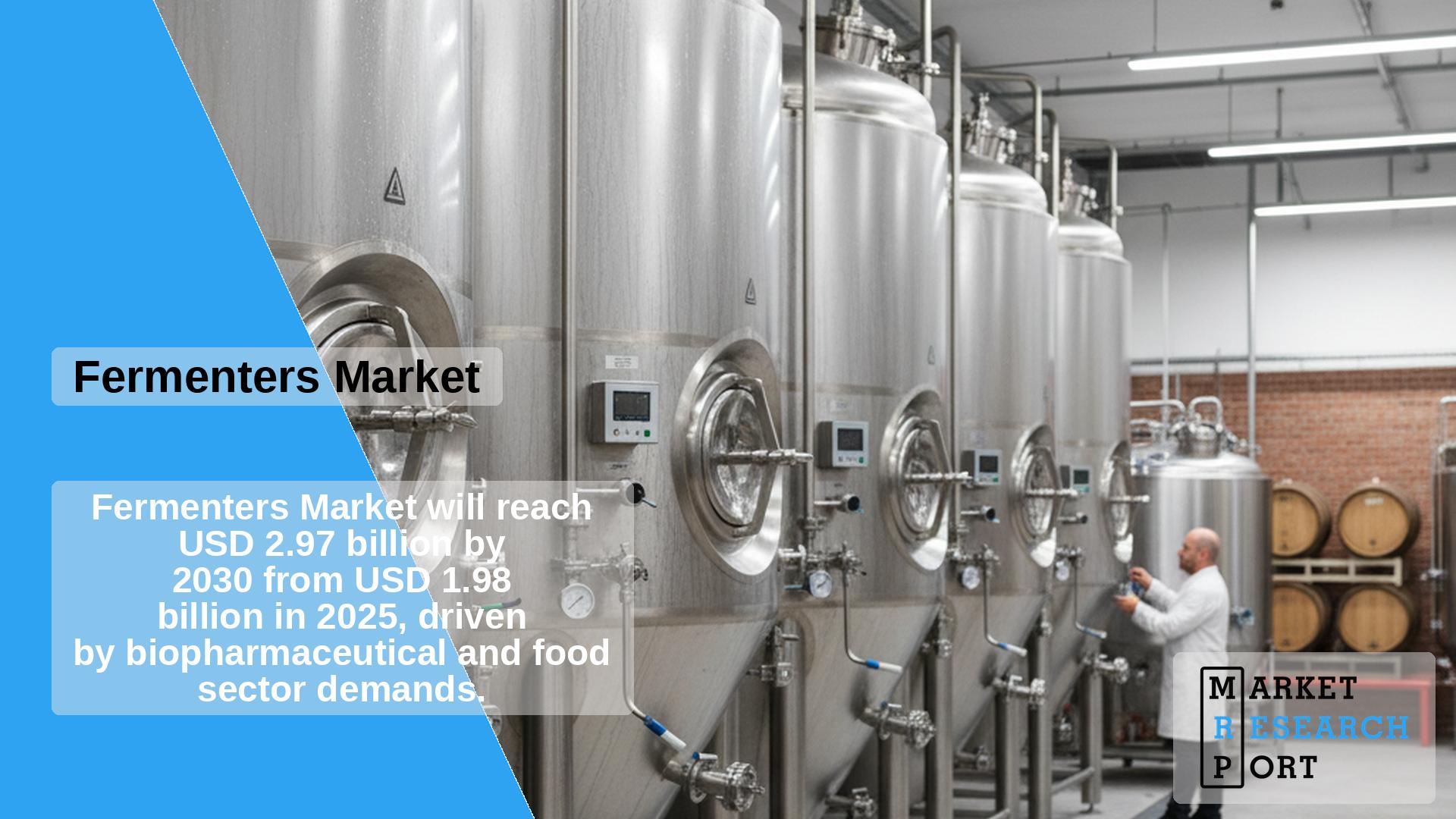
The global fermenters market size was valued at USD 1.98 billion in 2025 and is anticipated to grow to USD 2.97 billion by 2030, exhibiting a CAGR of 8.4% between 2025 and 2030. This growth is largely driven by escalating incidence of chronic illnesses such as cancer, diabetes, and cardiovascular diseases, which have increased the demand for innovative biological therapies.
Increasing demand for monoclonal antibodies and personalized medicines is accelerating bioproduction, hence boosting fermenters’ demand. The rise of sophisticated technologies that simplify complex manufacturing further supports market expansion. Fermenters provide controlled environments to cultivate microorganisms or to generate bioactive substances derived from such organisms, which are integral in pharmaceuticals, food, and industrial biotechnology.
The expanding biopharmaceutical sector, reliant on microbial fermentation for producing vaccines, enzymes, and antibodies, plays a pivotal role in market growth. With biologics forming a significant part of the pharma pipeline, there is intensified demand for advanced fermentation systems offering scalability, sterility, and compliance.
Technological innovations like single-use fermenters and automation streamline operations, enhance productivity, and reduce contamination risks. Emphasis on sustainable fermentation processes aligns with global eco-goals, driving adoption of renewable feedstocks and waste valorization. Asia Pacific is emerging as a key growth region, propelled by investments in biotech and food industries.
The fermenters market is moderately consolidated, with key players alongside numerous smaller manufacturers. Competition centers on innovation, product portfolios, and strategic collaborations. Notable players include Eppendorf AG, Sartorius AG, Thermo Fisher Scientific, Pierre Guerin SAS, and Applikon Biotechnology BV.
In 2024, companies engaged in product innovation, partnerships, and mergers to consolidate their market presence—for example, the Biotech Open Platform initiative in France, launched in June 2024 by collaborations between Danone, DMC Biotechnologies, Michelin, and Crédit Agricole Centre, includes fermenter facilities aimed at scaling fermentation technologies.
The food and beverage sector led the fermenters market in 2024, attributed to their critical role in processes like beer fermentation, wine production, and dough leavening. Yeast and sourdough cultures are common microbial agents in these applications, enhancing flavor and texture.
Pharmaceutical applications are expected to grow at an 8.0% CAGR through 2030, driven by fermenters’ use in producing vaccines, antibiotics, and bioactive ingredients. Their capability for large-scale manufacturing of therapeutic compounds supports rising drug demand globally.
Automatic fermenters dominated in 2024, favored for their ability to maintain consistent conditions, enabling uniform batch quality, real-time parameter control, and increased productivity. Semi-automatic fermenters offer a balance of control and cost efficiency, suitable for smaller-scale operations.
Bacteria-based fermenters accounted for the largest market share, owing to bacteria’s metabolic diversity and ability to produce enzymes, organic acids, vitamins, and biofuels. Fungi, including molds used in fermentation of foods like cheese and soy sauce, also contribute significantly, advancing fermenter utilization across food and pharmaceutical sectors.
Fed-batch fermentation leads the market, offering enhanced control over nutrient feed and fermentation conditions, maximizing yields and cell densities. This process is widespread in pharmaceuticals and industrial enzyme production. Continuous fermentation is gaining popularity for its steady-state operation, higher productivity, and cost efficiency in large-scale biofuel and biochemical manufacturing.
North America recorded strong fermenters demand in 2024, supported by increasing biopharmaceutical manufacturing and sustainable production investments. The U.S. market leads in this region, underscored by significant facility expansions such as Lonza’s 4,000L fermenters added in 2024 to meet drug manufacturing needs.
Europe, led by Germany, dominates globally due to advanced fermenter technology adoption, growth in fermented foods, and consumer interest in cultured and plant-based products. Germany accounts for the highest regional revenue, with robust biopharma and food industries driving fermenter demand.
Asia Pacific shows strong growth prospects fueled by biotech investments, rising consumption of fermented foods and beverages, and governmental initiatives promoting vaccine production and sustainable manufacturing, positioning countries like China and India as critical market hubs.
| Market size value in 2025 | USD 1.98 billion |
| Revenue forecast in 2030 | USD 2.97 billion |
| Growth rate | CAGR of 8.4% from 2025 to 2030 |
| Base year for estimation | 2024 |
| Historical data | 2018 – 2023 |
| Forecast period | 2025 – 2030 |
| Quantitative units | Revenue in USD billion and CAGR from 2025 to 2030 |
| Report coverage | Revenue forecast, company ranking, competitive landscape, growth factors, and trends |
| Segments covered | Application, mode of operation, process, microorganisms, region |
| Regional scope | North America; Europe; Asia Pacific; Latin America; Middle East & Africa |
| Country scope | U.S.; Canada; Mexico; Germany; UK; France; Italy; Spain; China; Japan; India; South Korea; Brazil; Argentina; South Africa; Saudi Arabia |
| Key companies profiled | Eppendorf AG; Sartorius AG; Pierre Guerin SAS; Applikon Biotechnology BV.; GEA Group; Cercell APS; ElectroLab Biotech Ltd.; Zeta Holding GmbH; Thermo Fisher Scientific Inc.; New Brunswick Scientific Co., Inc. |